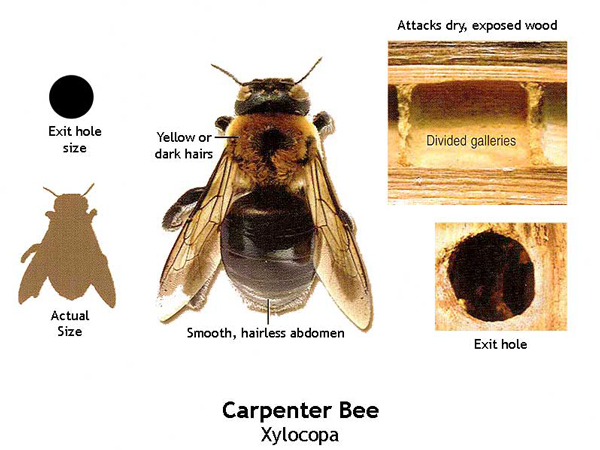Yes, Carpenter Bees Can Nest Again in Your Deck
By Chris Williams on April 2, 2013.
Question
We had a problem last year with those big black bees making holes in our deck railings. Will they be back again this spring? Is there anything we can do to reclaim our deck!?
Answer
You’re talking about carpenter bees. They look a lot like bumble bees, which nest in the ground, except carpenter bees have shiny black abdomens instead of fuzzy black abdomens. Carpenter bees make their nests in wood, particularly soft woods that are weathered and unpainted or unsealed.

Carpenter bee problems are seasonal. Any time now you can expect to see carpenter bees buzzing about, scouting for nest sites. In our area, nest building takes place mostly in May. Unfortunately, carpenter bees do tend to re-nest in the same areas where they built nests the previous year. Sometimes they even re-use the same nest opening. It’s the male carpenter bee that is so intimidating. He patrols the nest site while the female is excavating the nest hole and laying eggs inside. The male dives and buzzes at anything that comes near; apparently he doesn’t know that he doesn’t have a stinger and is basically harmless. The female does have a stinger but she’s docile and too busy building a nest.
It takes the female about a week to construct and provision her nest. She uses her jaws to chew a perfectly circular, dime-sized tunnel in the wood. Inside the tunnel, she constructs 6 to 8 brood cells and supplies each one with a ball of pollen and an egg. The hatching bee larvae feed on the pollen and pupate inside their cells. Once the female completes her nest, the pair leave the area and die shortly after. In later summer, new adult carpenter bees emerge from the nest, and often spend the winter inside the old galleries.
Your deck is probably either unsealed or any paint or sealer has worn away. Carpenter bees prefer to nest in softwoods such as redwood, cedar, teak, fir, and pine. Outdoor decks, deck furniture, cedar shingles, and unpainted edges of fascia board, soffits, and roof trim are favorite nest sites.
Carpenter bees leave behind nest holes in the wood and yellow fecal stains on the surface below the nest opening. Fortunately carpenter bee damage is mostly cosmetic. However damage can be serious when they nest in groups, or reinfest old nest sites the following year, or if woodpeckers attack the wood trying to reach the carpenter bee larvae inside—a common occurrence.
If you apply some kind of a finish to your deck wood, that should help prevent carpenter bee nesting. Wood stain or pressure treatment alone won’t always deter the bees, though, and they’ve been known to go through only a light coat of paint.
To prevent carpenter bee nesting this year, call us today. We can treat the deck area and inject and plug the old nest holes to deter new nest building. We will also inspect for other areas where the bees may have been nesting around your home. Nest holes are not always easily visible, often located on the undersides of railings or the backsides of fascia boards. We’re experts at pest-proofing and our technicians can treat wood, seal openings, and block access to areas on your home where bees have been nesting. Give us a call today and get ready to barbecue!